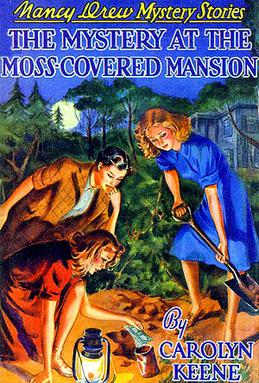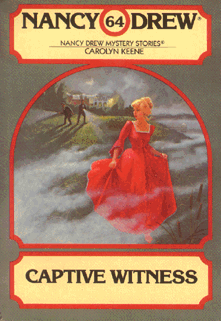
Nancy Drew is a fictional character appearing in several mystery book series, movies, video games, and a TV show as a teenage amateur sleuth. The books are ghostwritten by a number of authors and published under the collective pseudonym Carolyn Keene. Created by the publisher Edward Stratemeyer as the female counterpart to his Hardy Boys series, the character first appeared in 1930 in the Nancy Drew Mystery Stories series, which lasted until 2003 and consisted of 175 novels.

Mildred Augustine Wirt Benson was an American journalist and writer of children's books. She wrote some of the earliest Nancy Drew mysteries and created the detective's adventurous personality. Benson wrote under the Stratemeyer Syndicate pen name, Carolyn Keene, from 1929 to 1947 and contributed to 23 of the first 30 Nancy Drew mysteries, which were bestsellers.
Carolyn Keene is the pseudonym of the authors of the Nancy Drew mystery stories and The Dana Girls mystery stories, both produced by the Stratemeyer Syndicate. In addition, the Keene pen name is credited with the Nancy Drew spin-off, River Heights, and the Nancy Drew Notebooks.
The Stratemeyer Syndicate was a publishing company that produced a number of mystery book series for children, including Nancy Drew, The Hardy Boys, the various Tom Swift series, the Bobbsey Twins, the Rover Boys, and others. They published and contracted the many pseudonymous authors doing the writing of the series from 1899 through 1987, when the syndicate partners sold the company to Simon & Schuster.

The Bungalow Mystery is the third volume in the Nancy Drew Mystery Stories series written under the pseudonym Carolyn Keene. It was the last of three books in the "breeder set" trilogy, released in 1930, to test-market the series.

The Secret of the Old Clock is the first volume in the Nancy Drew Mystery Stories series written under the pseudonym Carolyn Keene. It was first published on April 28, 1930, and rewritten in 1959 by Harriet Stratemeyer Adams.

Franklin W. Dixon is the pen name used by a variety of different authors who were part of a team that wrote The Hardy Boys novels for the Stratemeyer Syndicate. Dixon was also the writer attributed for the Ted Scott Flying Stories series, published by Grosset & Dunlap.

The Mystery at Lilac Inn is the fourth volume in the Nancy Drew Mystery Stories series. It was first published in 1930 under the pseudonym Carolyn Keene. Mildred Wirt Benson was the ghostwriter of the 1930 edition.

The Clue in the Diary is the seventh volume in the Nancy Drew Mystery Stories series, and was first published in 1932 under the pseudonym Carolyn Keene. Its text was revised in 1962.

The Sign of the Twisted Candles is the ninth volume in the Nancy Drew Mystery Stories series. As the second volume written by Walter Karig, it was originally published in 1933 under the pseudonym Carolyn Keene. Due to Karig having died in 1956, as of January 1, 2007, the 1933 book and the other two Nancy Drew books he wrote, have passed into the public domain in Canada and other countries with a life-plus-50 policy.

The Password to Larkspur Lane is the tenth volume in the Nancy Drew Mystery Stories series. It was first published in 1933 under the pseudonym Carolyn Keene. The actual author was ghostwriter Walter Karig in his third and final Nancy Drew novel and his final appearance for the Stratemeyer Syndicate. Due to Karig's death in 1956, this book and his other two Nancy Drews, as of January 1, 2007, have passed into the public domain in Canada and other countries with a life-plus-50 policy.

The Clue of the Broken Locket is the eleventh volume in the Nancy Drew Mystery Stories series. It was first published in 1934 and was written by Mildred Benson under the pseudonym Carolyn Keene. It was later revised by Harriet Stratemeyer in 1965, and the story was mostly changed with a few elements of the original.

Walter Karig was a prolific writer, who served as a US naval captain. Karig wrote a number of works on Allied naval operations during World War II. He also wrote scripts for the television series Victory at Sea. Besides his works on naval history, Karig was a novelist, publishing under his own name, and a journalist.

The Mystery of the Ivory Charm is the thirteenth volume in the Nancy Drew Mystery Stories series. It was first published in 1936 under the pseudonym Carolyn Keene. The actual author was ghostwriter Mildred Wirt Benson.

The Mystery at the Moss-Covered Mansion is the eighteenth volume in the Nancy Drew Mystery Stories series published by Grosset & Dunlap, and was first published in 1941. The original text was written by ghostwriter Mildred Wirt Benson, based upon a plot outline from Stratemeyer Syndicate co-owner Harriet Stratemeyer Adams. The book's title was changed to Mystery of the Moss-Covered Mansion when it was revised in 1971, because the story is completely different and not much of the investigation takes place at the title location. In the original, many plots and much investigation all tie back to the same house deep in the forest, while Nancy helps her father locate an heiress, expose an impostor, investigate a murder, and look into strange screams at the mansion; none of the action in the original story took place in River Heights.

The Mystery of the Tolling Bell is the twenty-third volume in the Nancy Drew Mystery Stories series. It was first published in 1946 under the pseudonym Carolyn Keene. The actual author was ghostwriter Mildred Wirt Benson.

The Ringmaster's Secret is the thirty-first volume in the Nancy Drew Mystery Stories series. It was first published in late 1953 under the pseudonym Carolyn Keene. The actual author was ghostwriter Harriet Stratemeyer Adams.

The Thirteenth Pearl is the fifty-sixth volume in the Nancy Drew Mystery Stories series. It was first published in 1979 under the pseudonym Carolyn Keene. The actual author was ghostwriter Harriet Stratemeyer Adams. The Thirteenth Pearl is the end of the original 56-book series published by Grosset & Dunlap. Subsequent volumes were published by Simon & Schuster.

Captive Witness is the 64th volume in the Nancy Drew Stories series. It was originally published in 1981 by the Wanderer imprint of Simon & Schuster and ghostwritten by Richard Ballard. Scholastic also released a version of the book, titled as Captive Witness Mystery. The original edition cover was by Ruth Sanderson, with six internal illustrations by Paul Frame.
The Nancy Drew Mystery Stories is the long-running "main" series of the Nancy Drew franchise, which was published under the pseudonym Carolyn Keene. There are 175 novels — plus 34 revised stories — that were published between 1930 and 2003 under the banner; Grosset & Dunlap published the first 56, and 34 revised stories, while Simon & Schuster published the series beginning with volume 57.
















